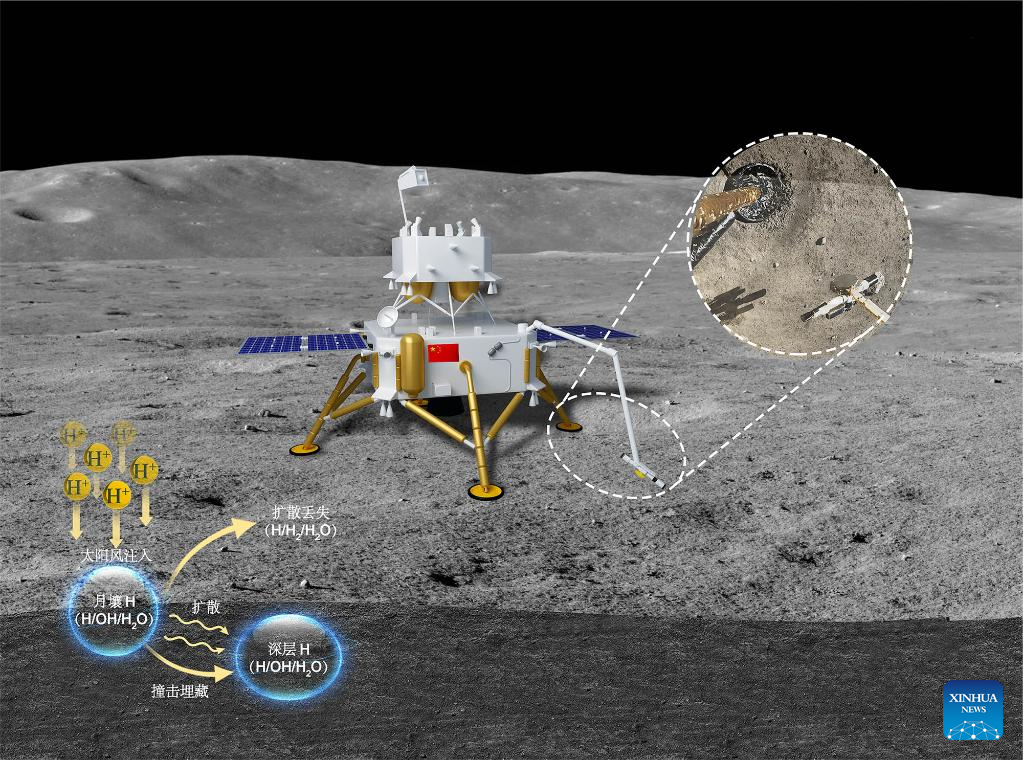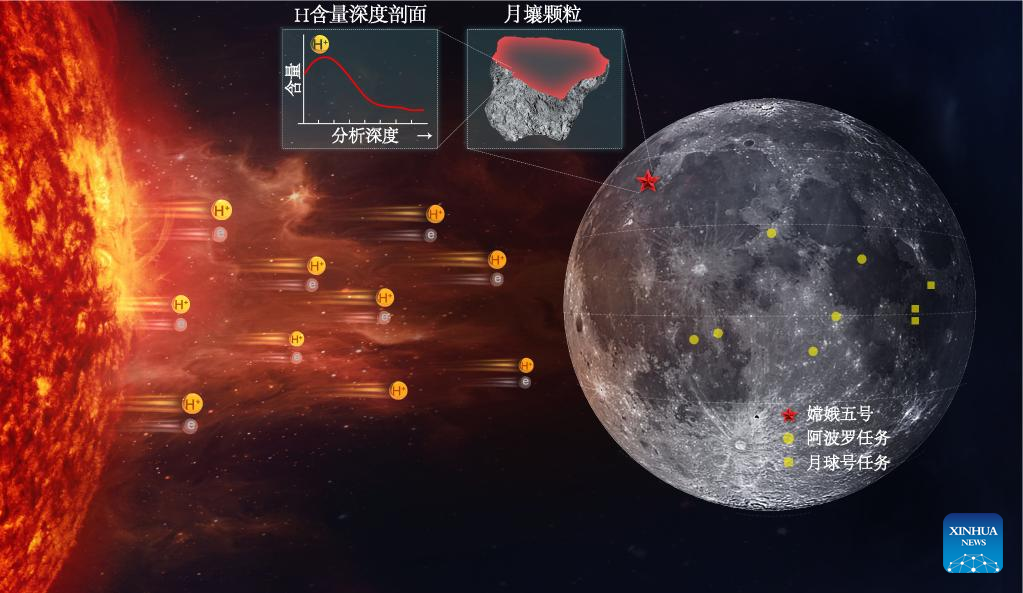
The model diagram drawn on Nov. 23, 2022 shows the implantation, preservation and diffusion loss of hydrogen from the solar wind. (IGGCAS/Handout via Xinhua)
BEIJING, Dec. 13 (Xinhua) -- By studying lunar samples retrieved by the Chang'e-5 mission, Chinese scientists found that lunar soil grains retain more solar wind-implanted water at the middle latitude region than previously thought.
Based on this finding, the scientists predict that there is a large amount of water resources available for utilization at the high latitude region of the moon.
Scientists had previously discovered the presence of surficial water on the moon. They believed that solar wind implantation, volcanic outgassing, and asteroid/comet impacts are likely to be important sources of surficial water on the moon.
But how does water reach and remain on the moon? How much water is in the lunar soil? How is the water distributed spatially? A study of the lunar soil samples returned by China's Chang'e-5 mission has shed new light on these questions.
The research team, jointly led by scientists from the National Space Science Center (NSSC) and the Institute of Geology and Geophysics (IGG), both under the Chinese Academy of Sciences (CAS), published the new findings on Tuesday in the latest edition of the journal Proceedings of the National Academy of Sciences.
Lin Yangting, a researcher at the IGG who led the study, explained that the water they refer to is not water in the usual sense, but the structural water found in soil grains. Since hydrogen is one of the main components of water, the hydrogen concentration is usually used to express the water content.
The research team selected 17 lunar soil grains, including olivine, pyroxene, plagioclase and glass, from Chang'e-5 samples and carried out experimental analysis of the hydrogen content and isotopes using a newly-developed profiling technique on a nanoscale secondary ion mass spectrometer.
The scientists found that the average water content in the topmost 0.1-micron zone of the lunar grains is 0.7 weight percent, rather high for nonaqueous minerals. They then proved through the deuterium-hydrogen ratios that the water on the lunar surface was solely derived from the solar wind.
"The hydrogen ions emitted from the Sun reach at an average speed of 450 kilometers per second and they hit the surface of the lunar soil grains like bullets," said Tian Hengci, the paper's co-first author, an associate professor at the IGG.
Based on the analysis of heating experiments, the research team conducted the simulations on the preservation of hydrogen in lunar soils at different temperatures, and the results showed that the solar wind-originated water could be well preserved in the middle and high latitude regions of the lunar surface.
Previously, scientists were unable to use the returned samples to study the possible influence of latitude on water content on the lunar surface, since the lunar samples collected by the Apollo missions of the United States and the Luna missions of the Soviet Union were all from the low latitude areas of the moon.
China's Chang'e-5 mission successfully retrieved 1,731 grams of lunar samples at the end of 2020. The probe landed at 43.06 degrees north latitude of the moon, higher than the latitudes of the landing sites of the Apollo and Luna missions. In addition, the crystallization age of the basalt in the Chang'e-5 landing area is about 2 billion years old, much younger than the sampling areas of the Apollo and Luna missions.
"The Chang'e-5 samples provided us with the opportunity to study the evolution of solar wind, and the implantation and migration of water on the lunar surface," said Xu Yuchen, the co-first author of the paper from the NSSC.
The research team built a dynamic equilibrium model between hydrogen implantation by solar wind and diffusion loss by heating, based on the analysis results of the Chang'e-5 samples and the experimental data of the Apollo samples.
The model predicted that lunar grains in the high latitude region contain more solar wind-delivered water in their rims. The topmost 0.1-micron zone of the lunar grains could contain as much as 8.5 weight percent of water. And if the lunar soils are sorted by particle size, the water content in the particles less than 2 microns could reach 2 weight percent.
"This discovery is of great significance for the future utilization of water resources on the moon. China plans to build a scientific research station in the south polar region of the moon. Our research shows that the south polar region of the moon may have more water than previously thought. And it is relatively easy to exploit and use the water contained in the lunar soil through particle size sorting and heating," said Lin. ■

In this diagram drawn on Nov. 23, 2022, hydrogen ions from the Sun are implanted into the lunar surface at a high speed and are preserved in the surface layer of lunar soil grains. (IGGCAS/Handout via Xinhua)



